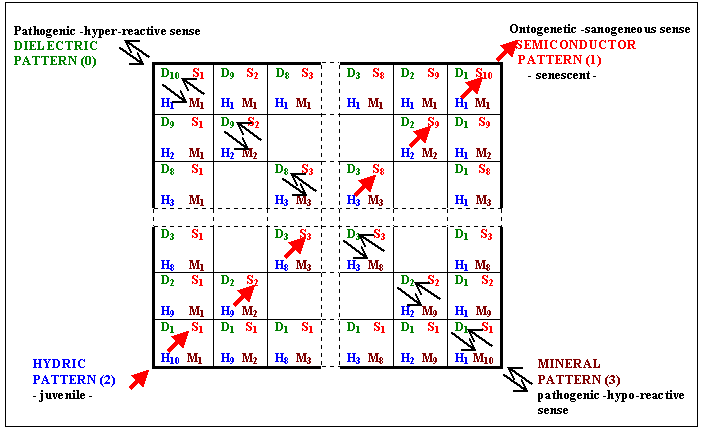Anthropology of the individual - term proposed for a new field, makeing an interdisciplinary approach to the human individual, in his whole somatic, psychic and spiritual complexity. We have built a nuber of models for the human being: the systemic model (Fig.1) , the interface modelling (Fig.2) and (Fig.3) , the integronic model (Fig.4).
Body aura - universal and fundamental form of existence, which accompanies the material existence and the fields existence (gravitational and electromagnetic field). We have approached the scientific study using the electrographic method of the living and non-living bodies, and we have established a semiology for the electromagnetic signals appearing in the bodies' auras.
Information of the aura - fundamental property, characterizing the bodies aura - present everwhere - , similar to the bodies mass which characterizes the quality of substance, and similar to the energy, which characterizes the quality of field. The aura's information shows up as archetypal information. We have highlighted the following archetypal forms: globular, ramnified, radial and floral.
Integronics - this is a name proposed in 1977 for a new theoretical field which explains our experimental results, and studies the general laws of the coexistence of the three fundamental forms: the substance, the field and the aura.
Electrography - method of scientific research (Romanian invention, Fl.I.Dumitrescu, 1975, completed by C. Guja, 1977-2002), used for the systematic study of body auras. The synthesis of our results has lead to human bioelectric types, with adaptive roles, similar to the adaptive roles of the blood groups.
Experimental basis:
samples of electrographic images:
Graphite plate... Water drop... Human palm... Human fingers...
The sinthesys in the following figure :

contains the result of the systematization of our experimental data and of the integration in a logical-mathematical and informational diagnosis system.
We have highlighted five categories of EG palm images (the hand defines and expresses the human being by means of its communication and integration potentialities; it is a creative means, complementary to the creating activity of the brain, an informational archetypal expression of the human being defined by polarity, complementarity and symmetry/asymmetry).
The analysis of these categories, based on thousands of experimental cases , has demonstrated the existence of five human bioelectrical types. These types have qualities and selective-adaptive potentialities which are different in the electromagnetic living environment, analogous to the biochemical-adaptive functions proper to the ABO blood groups.
Comparative observation of the EG bioelectric types highlights clear differences among the four pure patterns: dielectric, hydric, mineral, semiconductor, which marks extreme states of the ontogenetic-sanogenous sense (juvenile<-->senescent) or of the pathogenic, reversible sau irreversible tendencies (hyper-reactive<-->hypo-reactive).
The statistic study on various samples of healthy and sick subjects reveals the existence, in most cases, of a mixed type, placed in the central area of the matrix, characterized by the presence of all the four patterns that define the pure EG types. So, each individual finds its place, at a certain moment, within a square of the matrix, corresponding to the proportion of the four values of the patterns (0, 1, 2, 3), which vary according to the normal and pathological phyological status.
The EG image presents a snapshot of the informational dynamics of the halo, consisting in a variable EG imprint alongside with the unique, genetically determined, dermatogliphic imprint.
The interpretation of the state of health/sickness by reading the EG signals, encoding the
ramnified archetype, was also achieved by making an analogy with the significance of the natural arborescent forms: the aspect of a tree reflects its state of viability, vitality, reliability, by appreciating its global shape, overall aspect, the density and complexity of the branching of crown and roots.
The ramnification is a characteristic form of the communication phenomena, which we meet everywhere in nature. Due to its frequency of appearance in the natural phenomena, it made itself obvious as a study hypothesis for the phenomena of informational communication. The significance of the ramnification as an archetypal form af comunication was confirmed by our laboratory experiments.
![]() home
home